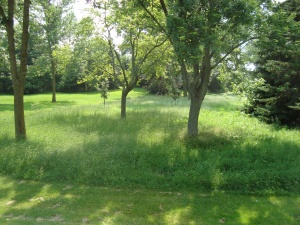Difference between revisions of "Turf"
Jump to navigation
Jump to search
Jenny Hill (talk | contribs) m |
Jenny Hill (talk | contribs) m |
||
| Line 4: | Line 4: | ||
[[File:Example4.jpg|thumb|I have no information about this image]] | [[File:Example4.jpg|thumb|I have no information about this image]] | ||
Revision as of 17:30, 19 December 2017
Best practices for mown turf
Close mowing removes leaves and increases shoot production, leading to a denser 'velvety' appearance. But this 'damage' also reduces the plant's photosynthetic processes and stunts its growth. Notably, when grass is stressed by close pruning, it doesn't have the resources to develop deeper roots. The shallow roots in turf grass make it particularly susceptible to drought conditions and significantly weakens the resiliency of the grass. Any pruning (including mowing) introduces cut edges on the leaf blades, increasing the potential for disease.
Turf grass mixtures in Ontario often containa high proportion of Kentucky Bluegrass [1]. For optimal long term health and resiliency, this turf should be cut no shorter than 7 cm. [2]
- ↑ OMAFRA Lawn Establishment July 2008 http://www.omafra.gov.on.ca/english/crops/facts/08-025w.htm#turf Accessed Dec 19, 2017
- ↑ Karen Panter, Turf and Water, Sept 12, 2013 https://www.slideshare.net/kpanter/turf-and-water Accessed Dec 19, 2017
